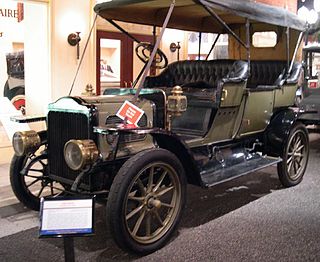Related Research Articles
The White Motor Company was an American automobile, truck, bus and agricultural tractor manufacturer from 1900 until 1980. The company also produced bicycles, roller skates, automatic lathes, and sewing machines. Before World War II, the company was based in Cleveland, Ohio. White Diesel Engine Division in Springfield, Ohio, manufactured diesel engine generators, which powered U.S. military equipment and infrastructure, namely Army Nike and Air Force Bomarc launch complexes, and other guided missile installations and proving grounds, sections of SAGE and DEW Line stations, radars, Combat Direction Centers and other ground facilities of the U.S. aerospace defense ring, such as the Texas Towers.
The Locomobile Company of America was a pioneering American automobile manufacturer founded in 1899, and known for its dedication to precision before the assembly-line era. It was one of the earliest car manufacturers in the advent of the automobile age. For the first two years after its founding, the company was located in Watertown, Massachusetts. Production was transferred to Bridgeport, Connecticut, in 1900, where it remained until the company's demise in 1929. The company manufactured affordable, small steam cars until 1903, when production switched entirely to internal combustion-powered luxury automobiles. Locomobile was taken over in 1922 by Durant Motors and eventually went out of business in 1929. All cars ever produced by the original company were always sold under the brand name Locomobile.

The American Locomotive Company was an American manufacturer of locomotives, diesel generators, steel, and tanks that operated from 1901 to 1969.

The Brass Era is an American term for the early period of automotive manufacturing, named for the prominent brass fittings used during this time for such things as lights and radiators. It is generally considered to encompass 1896 through 1915, a time when these vehicles were often referred to as horseless carriages.
The American Steamer was an American steam car manufactured by the American Steam Truck Co. of Elgin, Illinois, from 1922 to 1924.

De Dion-Bouton was a French automobile manufacturer and railcar manufacturer operating from 1883 to 1953. The company was founded by the Marquis Jules-Albert de Dion, Georges Bouton, and Bouton's brother-in-law Charles Trépardoux.

A steam car is a car (automobile) propelled by a steam engine. A steam engine is an external combustion engine (ECE) in which the fuel is combusted outside of the engine, unlike an internal combustion engine (ICE) in which fuel is combusted inside the engine. ECEs have a lower thermal efficiency, but carbon monoxide production is more readily regulated.

Stevens-Duryea was an American manufacturer of automobiles in Chicopee Falls, Massachusetts, between 1901 and 1915 and from 1919 to 1927.

Development of the automobile started in 1672 with the invention of the first steam-powered vehicle, which led to the creation of the first steam-powered automobile capable of human transportation, built by Nicolas-Joseph Cugnot in 1769. Inventors began to branch out at the start of the 19th century, creating the de Rivas engine, one of the first internal combustion engines, and an early electric motor. Samuel Brown later tested the first industrially applied internal combustion engine in 1826.
Abner Doble was an American mechanical engineer who built and sold steam-powered automobiles as Doble Steam Cars. His steam engine design was used in various automobiles from the early 1900s, including a 1969 General Motors prototype and the first successful steam-powered aeroplane.

Gaeth was an American steam automobile manufactured in Cleveland, Ohio from 1902 until 1911.
The Keystone Steamer was an American automobile manufactured from 1899 until 1900 in Lebanon, Pennsylvania.

A car is a wheeled motor vehicle used for transportation. Most definitions of cars say that they run primarily on roads, seat one to eight people, have four wheels, and mainly transport people rather than goods.

The "'Jackson Automobile Company'" was an American Brass Era automobile manufacturer located in and named for Jackson, Michigan. The company produced the Jackson from 1903 to 1923 and the 1903 Jaxon steam car and the 1904 Orlo.

Established in St.Louis in 1899 by A.L.Dyke, Dyke was the first American auto parts business. Dyke also sold early autos, kit car or assembled. In addition to the Dyke name, the company also sold automobiles under the St. Louis and Dyke-Britton names.
Nordberg Manufacturing Company was a manufacturer of steam engines, large diesel engines, pumps, hoists and compressors for the mining and quarry industries located in Milwaukee, Wisconsin.

Overman Wheel Company was an early bicycle manufacturing company in Chicopee Falls, Massachusetts from 1882 to 1900. It was known for bicycles of higher quality and lower weight than other bicycles of its time. Despite a nationwide bicycle craze in the late 1800s, the company was undercut by lower-priced competition, nearly went bankrupt in 1897, and never recovered from an 1899 fire. The company was sold in 1900.
References
- ↑ 100 Years of the American Auto Millennium Edition, Copyright 1999 Publications International, Ltd.
- ↑ "Victor Steam Carriage, Overman Wheel Company, & Overman Automobile Company". www.virtualsteamcarmuseum.org. Retrieved 2016-07-29.
- ↑ Georgano, G. N., Encyclopedia of American Automobiles, (New York, E. P. Dutton & Co., 1968), p. 147.